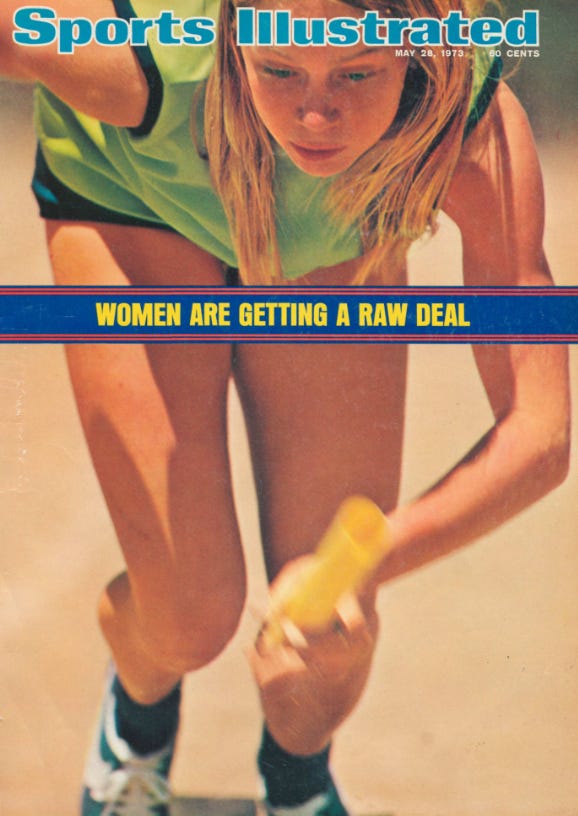#FromtheArchives: 'Sport Is Unfair to Women' (Sports Illustrated, 1973)
Part 1 of our look back at a game-changing series on gender inequity in sports, pre-Title IX.
Hi, friends! First off, a hearty welcome to all of the new subscribers! It’s been a big week here at Power Plays, as we launched our Sylvia Fowles Holiday Special — the biggest sale in Power Plays history — and made it all the way to CNN thanks to Tuesday’s newsletter, “What’s at stake for the USWNT at the men’s World Cup.” (To my family members reading this: I promise I’ll share the video once I figure out how to get it from my DVR to my computer.)
All of this is only possible because of paid subscribers to Power Plays. If you haven’t become a paid subscriber yet — or if you have a monthly subscription and want to save some money — now is the time to join in the fun. Annual subscriptions are under $48, averaging out to less than $4 per month!!!
In today’s newsletter, we’re combining two of my favorite parts of Power Plays: Our #FromtheArchives series, where we look back at old coverage of women’s sports, and the Book Club!
We’ll be looking at part one of a groundbreaking three-part Sports Illustrated series in 1973 on inequity in women’s sports.
Remember, the Power Plays Book Club is currently reading “Inaugural Ballers: The True Story of the First U.S. Women’s Olympic Basketball Team” by Andrew Maraniss. (Here’s more information about where you can get the book! You’ll love it, I promise.)
Before we get into it, a couple of quick Book Club announcements:
On Thursday, December 15 at 7:00 p.m. ET we’ll be hosting a Virtual Power Plays Q&A on zoom with Andrew Maraniss, the author of “Inaugural Ballers” and Mary Anne O’Connor, one of the players on that historic 1976 team!
I’ll be sending out the zoom link to paid subscribers next week, but wanted to let you go ahead and get it on your calendars.The January/February Book Club selection is: “Hail Mary: The Rise and Fall of the National Women’s Football League” by Frankie de la Cretaz and Lyndsey D’Arcangelo!
Okay, friends. Let’s do this.
‘We do not need that kind of character in our girls’
In the early pages of “Inaugural Ballers,” Maraniss describes what the world was like for women in sports in the early 1970s, in the years just before the famed 1976 team took the court.
I was struck when he brought up a Sports Illustrated article, “Programmed to Be a Loser.” Maraniss writes that in this article reporters Bil Gilbert and Nancy Williamson “exposed the big lie in American sports, eviscerating conventional wisdom by claiming that it was not women’s frailty that limited their athletic opportunities, but men’s.”
Obviously, I immediately knew I had to find the article.
When digging through the Sports Illustrated archives, I found that this article was actually a three-part series published in consecutive weeks in the spring of 1973, right before Title IX was signed into law. And these articles are absolute GOLD.
This month we’ll be looking at all three of these groundbreaking articles, because Gilbert and Williamson’s phenomenal reporting paints the most thorough picture of women’s sports in the years prior to Title IX that I’ve ever seen, and they do such a good job of seeing through the bullshit excuses for the inequities.
Today, let’s start with the first part of the series, which was published on May 28, 1973.
The article is very long so I’m not going to screenshot it in its entirety. Rather, I’m just going to summarize some sections and pull out the excerpts that really bowled me over, either with their sharp analysis or devastatingly revealing/infuriating reporting. (I screamed *out loud* multiple times while working on this newsletter.)
Here’s one of the intro paragraphs, which really sets the stage for the series:
Read those last few sentences again:
There is a publicly announced, publicly supported notion that sports are good for people, that they develop better citizens, build vigorous minds and bodies and promote a better society Yet when it comes to the practice of what is preached, females – half this country’s population–find that this credo does not apply to them. Sports may be good for people, but they are considered a lot gooder for male people than for female people.
PHEW.
The piece goes on to provide some examples of gender inequity in sports on high school, college, and NCAA levels:
“In 1969 a Syracuse, NY school board budgeted $90,000 for extracurricular sports for boys; $200 was set aside for girls. In 1970 the board cut back on the athletic budget, trimming the boy’s program to $87,000. Funds for the girls’ interscholastic program were simply eliminated.”
“At the University of Washington, 41.4% of the 26,464 undergraduate students enrolled are women. However, when it comes to athletics women get only nine-tenths of 1% of the $2 million the university spends annually on sports.”
Of course, at the top of this pyramid? The NCAA. Gilbert and Williamson report that in 1973, the NCAA (est. 1910) had a budget of $1.5 million and 42 full-time employees. As we’ve discussed in Power Plays before, the NCAA didn’t oversee any women’s sports at the time, it didn’t see the point. So a group of women founded the Association for Intercollegiate Athletics for Women (AIAW) in 1971 to oversee women’s college athletics. In 1973, the AIAW had a budget of $24,000 a year and employed one part-time executive and one assistant.
All across the country, men were losing their minds at the thought of girls and women encroaching on their sporting kingdoms
Where this feature really shines is getting direct, DAMNING quotes from stakeholders across the country.
Here’s an anecdote from California about a men’s team walking off the floor because they couldn’t even fathom the indignity of playing against a woman. It was, the coach said, “humiliating.”
The Mission Conference, an eight-team league of California junior colleges, agreed not long ago that women could compete in varsity sports with and against men. Last February in a game against San Diego City College, Ray Blake, the basketball coach of San Bernardino Valley College, took advantage of the new ruling. Leading 114 to 85 with three minutes and 12 seconds to play, Blake sent in a substitute, Sue Palmer. The San Diego coach, Bill Standly, responded by calling time and asking his men, “Do you want to be humiliated any further by playing against a girl?” The team, to a man, said no, and San Diego walked off the court.
Here’s a high-school coach from Wisconsin indignant about not being able to use the girls’ gym 24/7, because girls are having the audacity to use it. So, naturally, he turns into the femininity police.
Ron Wied is the football coach at coed Pius XI in Milwaukee, the largest Catholic high school in the state. Wied says, “There is cause for concern among our male coaching staff over the pressure for girls’ sports. Facilities are a problem. We’ve got a boys’ gym and a girls’ gym. Before, we could use the girls’ gym for wrestling and the B team basketball a lot more than we can now. I think girls have a right to participate but to a lesser degree than boys. If they go too far with the competitive stuff they lose their femininity. I guess if I had my choice, I’d like to keep the boys’ teams going up in importance and let the girls stay about where they are now.”
Also in Wisconsin, spare a thought for the poor urinals.
John Roberts, the executive secretary of the Wisconsin Interscholastic Athletic Association, says many coaches of boys’ teams in his state are worried about the increased interest in girls’ sports. “The facilities thing will get worse,” says one of Roberts’ colleagues. “Girls haven’t figured out yet how to use the urinals.”
Are you screaming yet?
If not, here’s a story about a male Olympian in 1972 being so butthurt he wasn’t selected to be the flag bearer that he literally told a female colleague to get back to the kitchen.
At the Munich Games, Olga Connolly, a female discus thrower, was selected to carry the U.S. flag at the opening ceremonies. Upon learning that Connolly would be the American color-bearer, Russell Knipp, a weight lifter, said, “The flag-bearer ought to be a man, a strong man, a warrior. A woman’s place is in the home.”
A Connecticut judge gave one of the most enraging rulings imaginable, which barred girls from joining boys’ teams to protect the male ego
In Connecticut in 1971, a girl wanted to join the boys’ track team because her school didn’t have a girls’ team. She wasn’t allowed to do so, so she sued.
Now, I’d heard about this case before, but I don’t think I’d even read the decision until I read Gilbert and Williamson’s piece. I highly recommend you take a deep breath before proceeding.
Susan Hollander is a student at Hamden (Conn.) High School. She had sufficient talent to be a member of her school’s varsity cross-country and indoor track teams. There was no girls’ team, and she was prohibited by a state regulation from participating on the boys’ team. Backed by her parents, she brought suit against the Connecticut Interscholastic Athletic Conference. The case was heard on March 29, 1971 in the Superior Court of New Haven and Judge John Clark FitzGerald ruled against Hollander. In giving his decision Judge FitzGerald stated, “The present generation of our younger male population has not become so decadent that boys will experience a thrill in defeating girls in running contests, whether the girls be members of their own team or of an adversary team. It could well be that many boys would feel compelled to forgo entering track events if they were required to compete with girls on their own teams or on adversary teams. With boys vying with girls … the challenge to win, and the glory of achievement, at least for many boys, would lose incentive and become nullified. Athletic competition builds character in our boys. We do not need that kind of character in our girls.”
This man literally said that “the glory of achievement” would be RUINED for boys if they had to compete against girls!!!
Then he said, “Athletic competition builds character in our boys. We do not need that kind of character in our girls.”
He said that in an OFFICIAL LEGAL RULING.
It turns out, First Lady Lou Henry Hoover is responsible for the paltry state of women’s sports in 1973
I believe this anecdote speaks for itself.
Prudery is a major factor contributing to the present low estate of women’s sports. This hangup cannot be blamed on our Victorian or Puritan ancestors. Early in this century there was widespread participation by girls in competitive athletics. Baseball, bike racing and track and field were popular pastimes for girls. Basketball was played extensively, and often girls’ games were scheduled as doubleheaders with boys’ contests. Then in 1923, a national committee of women headed by Mrs. Herbert Hoover was formed to investigate the practice of holding such doubleheaders. The committee was shocked to find girls wearing athletic costumes performing before crowds that included men. Mrs. Hoover and her friends believed the girls were being used as a come-on and that the practice was disgraceful and should be stopped. State after state followed the advice and either abolished all girls’ sports or made them so genteel as to be almost unrecognizable as athletic contests.
Gilbert and Williamson did not left the media off the hook
The piece also debuted what I believe to be the first edition of #CoveringtheCoverage. Thankfully, Gilbert and Williamson scrutinized the article’s publisher, including this nauseating excerpt:
A fine (in the sense of being typical) example of women’s sports journalism appeared in the Aug. 23, 1971 issue of SI: “A cool, braided California blonde named Laura Baugh made quite a splash … her perfectly tanned, well-formed legs swinging jauntily. The hair on her tapered arms was bleached absolutely white against a milk-chocolate tan. Her platinum hair was pulled smartly back in a Viking-maiden braid ….” The account had to do with a women’s golf tournament.
MY GOD, you can literally read the drool. (Also: By saying “her perfectly tanned, well-formed legs swinging jauntily” did the writer just mean she was “walking?” Because if her legs were truly swinging on the golf course I don’t think she was playing well.)
Now, to continue with the media scrutiny, prepare yourselves for this kicker of a quote:
Between August 1972 and September 1973 NBC will televise 366 hours of “live” sport. Only one hour of this (the finals at Wimbledon) will be devoted to women. Til Fedenzi, manager of sports publicity for NBC, says, “Egad, I never thought about it before. I guess it’s not fair.” Bill Brendle, his counterpart at CBS, says, “We don’t know if women draw an audience –they might not be saleable.” During the coming year CBS will televise some 260 hours of men’s sports and 10 hours of women’s sports. ABC does not know how its time is divided between men and women athletes, but ABC’s Irv Brodsky says defensively, “Women don’t play sports.”
So, to recap: One network executive had never even thought about his company’s lack of women’s sports coverage, another network executive didn’t know if women’s sports could draw an audience and had absolutely zero desire to find out, and a third said simply, “Women don’t play sports.”
Next time anyone tells you that women’s sports aren’t on television because of “market forces,” not because of discrimination, just direct them to that paragraph.
Women in sports are always stuck in a ‘vicious paradox’
In its final pages, the article addresses how it’s not just conventional and overt discrimination that impacts women’s place in sports. Rather, there’s another “phenomenon” described: “It might be called psychological warfare; its purpose is to convince girls who show an inclination for athletics that their interest is impractical and unnatural.”
This phenomenon is perpetuated in a myriad of ways, such as girls being asked to wash the tables and straighten up the classroom while boys play at recess; parents prioritizing their son’s game over their daughter’s; and the societal scrutiny on an athletic girls’ appearance and sexuality as she hits her teenage years.
As we know, this scrutiny follows women in sports throughout their careers, and I thought this quote and analysis did a phenomenal job illustrating the consequences:
If a talented woman withstands these pressures and decides to become a serious athlete, she often has to cope not just with insinuations but with slanderous gossip. Jo Ann Prentice is a sharp-tongued, sharp-minded woman who has earned her living for 17 years on the LPGA tour. Asked about the “social” life on the tour, Prentice replied to the euphemistic question in her soft Alabama drawl. “This is kind of how it is. If you get into town at the beginning of the week and you meet some guy whose company you enjoy and have dinner with him once or twice, the gossips start asking what kind of tramps are these babes on the tour. If you stay at the motel where everybody else on the tour has checked in, then the question is what are those girls doing back in those rooms alone.”
The vicious paradox that Prentice outlines – women athletes are either heterosexual wantons or homosexual perverts or, simultaneously, both – is the culmination of all the jokes and warnings that began when an 11-year-old wanted to play sandlot football with her brothers and was teased, in good fun, about being a tomboy.
Tag yourselves in the blockquote above.
Okay, friends, that’s all for today’s edition of Power Plays! We’ll get to part two of the series soon, which Sports Illustrated teases as such:
NEXT WEEK: It is argued that sports are bad for a woman’s health and femininity, that she is not sufficiently skilled or interested to deserve expensive athletic programs of her own. So why spend the money? Old myths and new attitudes are examined in the second of a three-part series.
Thank you so, so much for the phenomenal support of Power Plays this week! Have a great weekend, and I’ll be back in your inbox shortly.







